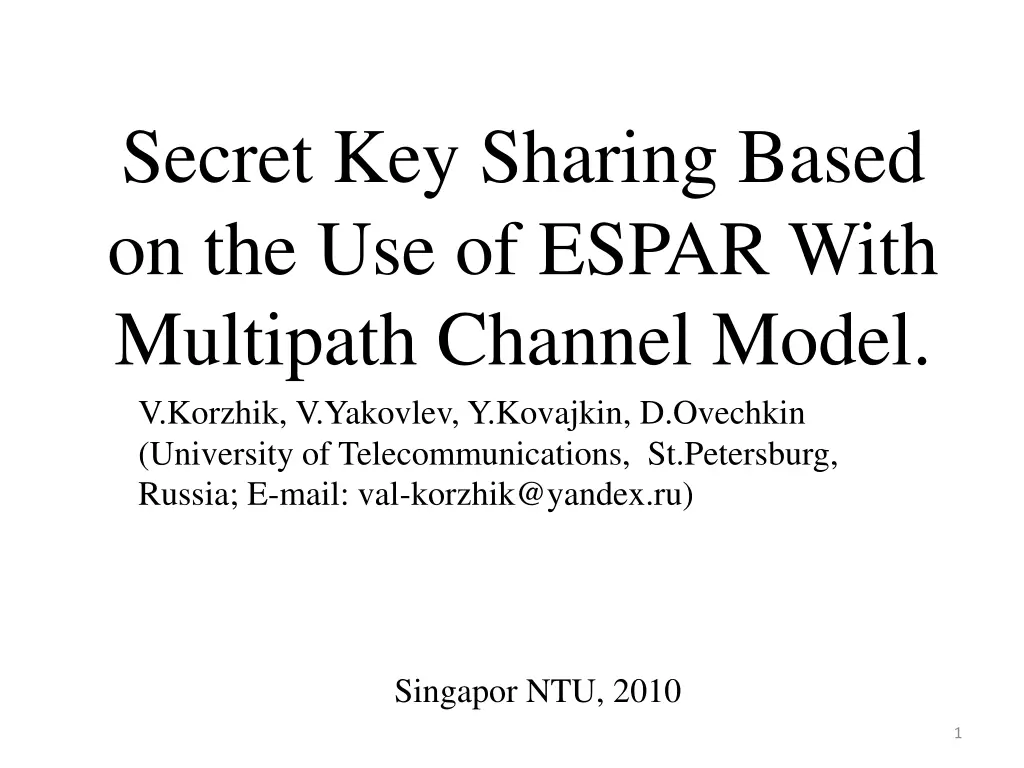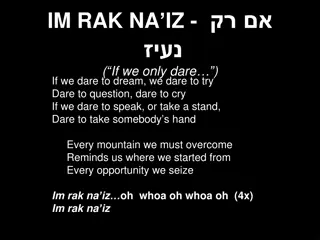
Secret Key Sharing Based on ESPAR With Multipath Channel Model
Learn about secret key sharing methods based on ESPAR with a multipath channel model. Explore techniques such as key distribution via satellite and privacy amplification. Understand wire-tap channel types and regular coding in the context of keyless cryptography.
Download Presentation

Please find below an Image/Link to download the presentation.
The content on the website is provided AS IS for your information and personal use only. It may not be sold, licensed, or shared on other websites without obtaining consent from the author. If you encounter any issues during the download, it is possible that the publisher has removed the file from their server.
You are allowed to download the files provided on this website for personal or commercial use, subject to the condition that they are used lawfully. All files are the property of their respective owners.
The content on the website is provided AS IS for your information and personal use only. It may not be sold, licensed, or shared on other websites without obtaining consent from the author.
E N D
Presentation Transcript
Secret Key Sharing Based on the Use of ESPAR With Multipath Channel Model. V.Korzhik, V.Yakovlev, Y.Kovajkin, D.Ovechkin (University of Telecommunications, St.Petersburg, Russia; E-mail: val-korzhik@yandex.ru) Singapor NTU, 2010 1
1. Introduction The main ways of key sharing: a) Transmission the keys over secure (encrypted) channels or a delivering them by special messengers; b) Using public key concept; c) Key sharing based on a presence of any noisy channel if adversary is passive, (wire-tap channel type I and II) [1,2,3] d) Key sharing based on a presence of active adversary if its channel is less noisy than channel of legal users. [4,5] e) Key sharing using quantum channels.[6] f) Key sharing based on a concept of anonymous channel. g) Key sharing based on a concept of broadcasting channel. h) Key sharing based on ESPAR-like radiator over multipath channels. [7,8] 2
Because method a) is trivial and b) is well known, we consider briefly methods c) g) and method h) in more details as a subject of our presentation. c) Source model with a passive eavesdropping . Aplication Key distribution via a satellite. Fact ( Maurer [3] ) if E K A 0 1 2 / , 1 2 / , 0 R E E B E 3
Privacy amplification ( Bennett , Brassard , Crepeau , Maurer [9,10]) The feature of keyless cryptography is : ( i ) Share the secret key by legal parties using this concept ( ii ) Use key - cryptography after receiving this key by legal parties (including perfect cipher) K C S K S C = = , To share secret key , A and B perform the following steps 1.A sends to B a truly random string x over public noisy channel . 2.A sends to B the check symbols to x chosen in line with some error correcting code V 3.A sends to B a truly random hash function h taken from universal class , which maps a string x of length n to string K of length k . 4.B corrects errors in the string x using check symbols transmitted by A . 5.Both A and B produce the key string as K = h ( x ) . Then the amount of information leaking over the wire - tap channel to eavesdropper E has the following upper bound [9,11] I bit 0 2 2 ), )/ ln ( n t k r ( where n is the length of x , k - is the length of the key K , r - is the number of check symbols , t - is the amount of collision ( Renyi ) information leaking over the wire - tap channel to eavesdropper E . ( t P P W W = + + 1 1 2 log ( ) ) 2 n for BSC - wire - tap channel with BER=Pw 2 4
Wire - tap channel type 2 . (Wyner [2]) An eavesdropper can observe a subset of his ( her ) choice of size t < n , where n is the block length Main applications - quantum cryptography (see in the sequel ) , optical fiber multiplexing , computer network containing eavesdroppers in some nodes Regular coding ( noiseless main channel ) The key shared by A and B is the following : K where H is the check matrix of some binary ( n , n-k ) code V , x is a binary string of length n radomly chosen by A and transmitted over the main public channel from A to B . Then the amount of information leaking over the wire - tap channel type 2 to easvesdropper is zero ( no easvesdropping at all ! ) providing the following inequality is true t d 1 where d is the minimum code distance of the code V = xH T which is dual of code V . 5
Example. V is ( 15 , 11 ) Hamming code . Then we have no easvesdropping about the key of length 4 if t 7 This concep can be exteded to noisy main channel ( Korjik , Kushnir [12]) . Privacy amplification [9] If A and B follow to the protocol described in the case type 1 in order to produce secret key, the amount of information leaking to eavesdropper has the following upper bound I 0 2 2 I0 )/ ln , n t K ( P where n is the length of x , K is the length of the key , P is the number of check symbols , t is the maximum number of bits that cavesdropper can obseved of each block . 6
d) A cryptographic scenario for source model (active illegal users ) Satellite S X( ) Y( ) A Alice Bob Z( ) E Eve 1 .- Initialization phase ( S (X,Y,Z ) over BSC- s with BER-s : A B E respectively ) , , 7
2.-Authentication phase : ( M , a ) , where M - a string consisting of k information bits , a - authenticator a = f ( M , X ) , where f ( , ) is a public function . Intruder s activity ( Upon receiving the pair ( M , a ) and knowing the authentication algorithm , to form a pair ( M , a ) , where M = M - substitution attack ) P - To be cheating by intruder ( the pair ( M , a ) is accepted by Bob as the original one ) P - To be rejection the original message by Bob when an intruder has not intervented into transmission at all . ( The length of the string ,,a as well as the length of the string X ( Y ) are very important parameters . ) BER - s between corresponding bits of X and Y , X and Z , Y and Z are , respectively : ~ ~ ~ ~ ~ Ch R e= e + e ( e ) = e + e ( e ) AB A B A B A B 1 - 2 e= e + e ( e ) = e + e ( e ) 1 - 2 AE A E A E A E 1 - 2 1 - 2 e= e + e ( e ) = e + e ( e ) BE B E B E B E 1 - 2 1 - 2 8
e e e e A E AB B E a) ( It is easy to show that this inequality results in impossibility for Bob to authenticate message sent by Alice []) e e e e < < b) A E AB B E ( It offers a positive solution for the authentication problem ) i -th position u1 M Code words of some binary block code of length n . 1 u M 2 2 u k M k 2 2 k n The value 1 in the i - th position of some code word indicates that i - th bit of the string X should be taken as a bit of the autheticator corresponding to the message compared with this code word . 9
Bob accepts the message as original if and only if the fraction of bits in the received authenticator that agree with the corresponding bits of his string Y is not much smaller than 1 - ( In non - asymptotic case some fixed threshold l should be chosen ) . The best substitution attack AB e 0 v a M X ~ M X a~ v~ Z ( ) ( ) = x ( ) ( ) = x ( ) ( ) = x 1 1 x Keep the authenticator s bits as they were in a ,, 0 1 x Put bits of Z - string ( ) = 0 1 0 0 x or The positions of the authenticator can be removed 10
~ The probability of substituting the message M for M without detecting this fact by Bob is determind by 0 1 distance between the code words and . ( This distance property differs from the ordinary Hamming distance ) x x x = 011 0 0101 v v = 11110111 ~ ~ v~ v v V ( ) v , ~ 01= v ~ , ( min v ) ~ d d v Definition 1 . 01 V Definition 2 . Constant weight authentication code : v / = l if , / V ( ) i 1 l ( ) = l i l 1 RP AB = + i l 0 11
( ) ( ) i l i l ( ) 0 ( ) = j 0 = j l d j AB1 l d j d i 1 d i BE P 01 01 01 01 BE Ch 0 = 0 i if d 01 l < if d l ( , the upper limit in the first sum in ( ) 0 01 0 d should be changed to 01 A simple construction of constant weigth codes ( due to Maurer-Wolf [4]) Take some linear binary ( n , K , d ) code and replace every bit in its code words by pair of bits following the rule : 0 01 1 10 12
It has been proved in [13] l l 1 ( l 1 ( ) ) + 1 AB AB l ) P l ) Re AB ( ( AB l [ + [ + d d 1 ( )] 1 ( )] P x x x sm sm Ch BE BE AB AB 2 b 2 b 2 c = x 2 , 1 a a a ) l = ( a AB BE = ( 1 ( ) b d AB BE sm = 1 c BE AB BE 13
It gives the authentication code with parameters : d d l 01 Example 1 . BCH ( 1023 , 208 , 231 ) code . Let : = , = , / / = / / = 2 , = n X Y n k k = 4 1 , 1 = 4 1 10 . P 10 , P = = , e e 0,2 0,0177 and then Ch AB BE R Optimization procedure . , , , BE P P R AB , , k Given the parameters Ch minimize the length l of the authenticator over all ( n , K , d ) linear codes . 14
R 0.45 12 34 5 6 7 0.4 1. 2. 3. 4. 5. 6. 7. 8. 9. BE = 0.45 BE = 0.40 BE = 0.35 BE = 0.30 BE = 0.25 BE = 0.20 BE = 0.15 BE = 0.10 BE = 0.05 0.35 0.3 8 R 0.25 9 0.2 0.15 0.1 0.05 0 1000 2000 3000 4000 5000 6000 7000 8000 9000 k k Relative date rate (R=k/(w+k) as a function of information block length k for different BEand fixed parametrs AB=0.01 ,PRe<10-4,PCh<10-4 15
0.45 R 0.4 0.35 1. 2. 3. 4. 5. 6. 7. 8. 9. BE = 0.45 BE = 0.40 BE = 0.35 BE = 0.30 BE = 0.25 BE = 0.20 BE = 0.15 BE = 0.10 BE = 0.05 1 2 3 4 5 6 7 8 0.3 R 0.25 0.2 0.15 9 0.1 0.05 k 0 1000 2000 3000 4000 5000 6000 7000 8000 9000 k Relative date rate (R=k/(w+k) as a function of information block length k for different BEand fixed parametrs AB=0.03 ,PRe<10-4,PCh<10-4 16
e) Quantum cryptography Basic quantum key distribution protocol. 1. A sends a random sequence of photons polarized horizontal ( ), vertical ( ), right-circular ( ), and left-circular ( ). 2. B measures the photons polarization in a random sequence of bases, rectlinear (+) and circular (o). 3. Results of B s measurments (some photons may not be recived at all). 4. B tells A whicj bases be used for each photons he recived. 5. A tells him which bases were correct. 6. A and B keep only the data from these correctly-measured photons, discarding all the rest. 7. This data is interpreted as binary sequence according to the coding scheme: 17
f) Anonymous Channel Eavesdropper learns all bits transmitted between legitimate users A and B but does not know who ( A or B ) is an author of any bit . Application . Key agreement protocol 18
g) Key sharing based on a concept of broadcasting channel. Satellite = a b c i i i i a i b i i A B i E = k = = = = ; ; k a k c b a k k k i c B i i i A B = ( / ) 0 I E i Fig. 1. The case g. 19
h) Key sharing based on ESPAR-like radiators over multipath channels (general theory) 2.1 Real word justification [7] Legal user A transmits a series of packets each with a different beam pattern generated by electronically steerable parasitic array radiator (ESPAR) The packets are received by legal user B, which builds up a sequence of received signal strength indicator (RSSI). After that B transmits packets back to A, where A builds up a sequence of RSSI data. Thanks to the reciprocity theorem of radio wave propagation between uplink and downlink, the sequence in A and B should be identical except for the random noise. Fig. 2. Key sharing procedure 20
Security of such key sharing is based on an assumption that the space locations of the eavesdropper and legal users are different. This results in a much greater disagreements key bits between legal users and eavesdropper. Raw disagreement bit distribution taken from [7] is shown in Fig.3. Sketch of experimental room is presented in Fig.4. Fig.4. Sketch of experimental room Fig.3. Raw disagreement bit distribution 21
2.2. Our contribution. We present general theory based on some model in order to prove security of the key sharing system with the use of privacy amplification. We propose space diversity technique for increasing of security because our simulation of ESPAR-like system showed that the use of single omnidirectional antenna is not sufficiently for high security level. In order to present a disagreement in key bits of legal users we propose to use both threshold-based and code-based methods. It is interesting to note that there exist here two seeming paradoxes : - we do not need in a presence of noise at eavesdropper s point to provide security, - large eavesdropper s probability of bit error can be provided even so if mutual correlation between legal and illegal RSSI is rather significant. 22
2.3. Model of key sharing setting (without additive noise). = , 1 = i 1 ' , R R R ; ) , 1 R y x i i i = ( , ij ij jk k ' , j , i x , L , ij , 0 0 , 0 0 j j = ' ) 1 ( j k j k , 1 = otherwise otherwise L L = i ' ; = ' , ) 1 , 0 ( N x y ; ( 2 ) where ij ij j i ij j i ij 1 ', correlation matrices which are given . . ( i i n j ' " " ( ) ) j k d . . i i ) d L ( on index = 1 j Here are the key j-th bits of legal users and eavesdropper, respectively, j are quadrature components of j-th RSSI of legal users and eavesdropper, respectively j i y the attenuations on the i-th beam of legal user and eavesdropper, respectively, the number of beams (pathes of wave propagations) ij ' the radiation coefficients of the ESPAR-like system on the i-th beam in the j-th packet for legal user and eavesdropper, respectively. 23
L , i y x , L Assumption: and model (1),(2) are public. = ' i 1 i Particular case: (if an eavesdropper is located near the legal user) ij ij = Correlation coefficient (general case): T XR Y ' ( = ( 3 ) , ) j j T XR T T T XR X YR Y Y ' Particular case: T T ( = , ) ( 4 ) j j T T T T XR X YR Y ' = = X Y ( , ,..., ), ( , ,..., ) x x x y y y where 1 2 1 2 L L If , then we get by (4) that (nothing security) Y X = X ) , ( j I R = ) , ( = j ( 1 , ( x j = , ) 1 j j If , then in general. In a particular case when Y j x y ) y = = x y , 0 ( , ) 0 , then if L N.B. ( Paradox 1) 24
More strong model (for KDP designer) Eavesdropper is able to separate beams ; e.q. he (or she) has : j y i ij i ,..., 1 , , 1 = = L ' N Then this means that for a particular case ( ) an eavesdropper is able to find = ' ij ij j k ' ij and hence to calculate the legal key bits exactly. ij This is not the case generally if ij Let us prove the key bit error probability for eavesdropper given the correlation p ) , ( j j e = 2 Var Var coefficient and variance j j Then we have after simple transforms (see Appendix 1) : 0 2 + 2 2 1 1 2 2 1 x xy y = = 2 exp ( ) pe dxdy arctg ( 5 ) 2 2 1 ( ) 2 2 2 1 0 25
It follows from (5) : (i) does not depend on but only on (ii) If , then ; if , then (in line with our intuition) The graph of versus is plotted in Fig.5. e p 0 p 2 1 e = = = 1 0 = e p e p 2 e p We can conclude that it is sufficiently to provide . (This is seeming Paradox 2). See Section 3 for detail. 95 , 0 p Fig.5. Dependence versus e 26
2.4. Two beam model. = y + pathes 2 x x General model: 1 1 2 2 = + ' ' y 1 1 2 2 (we drop index j for notation simplicity ) Particular case: + = 1 1 y y 1 ) , ( + 2 1 , 1 Var Var = = x x E is located very close to B. ' 2 2 ESPAR 2 2 = + + r E 1 1 2 2 + A (pathes 1) + + + r r ' B = 2 1 1 2 1 + 2 2 2 = 1 ( 2 )( = 1 2 = ) y r 1 1 1 2 x Fig.6. Two beam model of KDP ( , ) , , 2 2 r 1 2 1 2 x y 1 1 New setting with a separation of beams by eavesdropper. = ' 2 = + x x 2 y 1 1 2 2 ' 2 = + ( 6 ) ' ' ' x x = = = , , , x x y y given ( , ), , ' 1 y y 1 1 2 2 1 2 1 2 1 2 1 1 2 2 2 = ' 1 1 y 27 1
If E (as in Fig. 6 ) is between A and B, then = + = + ' ' ' ' x x x x 1 1 2 2 1 1 2 2 + + + + + ' ' ( r + 2 1 + 2 2 x ' ' ( 2 x ) ' r + ) ' r rx x x x r + r ( = = ( 7 ) , ) ' 1 + 2 1 2 2 2 1 2 2 + + + + ( 2 )( ' ' r 2 ) ' r x x x x x x 1 ( 2 )( ' ' r 1 2 ) ' r 1 2 1 2 2 2 x = 2 = = ' ' ' ' ' ( , ), ( , ), ( , ). r r r = , where 2 2 1 2 1 2 1 x = lim ( , ) ' 1 , that is reasonable. Particular cases: If r=1, then that is reasonable; ) ' , ( = 1 + ( ) r = = ' ' ' r ( , ) ' r + If r=0, then ; ( = + , ) ' 1 ( ) 1 ( ) If , then . 1 = = ( , ) ' 5 , 0 28
2.5. Simulation results of two beam model with ESPAR-like system: 1. Using a random exciting of ESPAR-like system* elements results in a random beam- forming antenna diagram. (The number of radiation patterns can be provided as untractable by appropriated choice of the number ESPAR-like system elements m and the number of the bias voltage bits : ) 2. Radiation pattern amplitude can be approximated by Gaussion distribution with variable expectation and variance. 3. Radiation pattern amplitudes of ESRR with 6 radiators are uncorrelated for angle interval more than 1-4 degree. The last point gives a chance to justify a general model in contrast to particular model (see slide 6). 1 m ( 2 ) * In our experiment we do not use ESPAR but electronically steerable ring radiator (ESRR) with 6 radiators equaly located on the circle of the radius 6 cm. We believe that ESRR gives more narrow beams than ESPAR 29
Let us consider two beam model (see slide (27)) = y + x x 1 1 2 2 ( 8 ) = + ' ' y 1 1 2 2 ) ( = sin s t w t If ESRR system generates signal , then using two beam wave propagation scheme we get: cos( )), ( cos( 2 2 0 0 1 1 = = V y t w V y 0 = = t ( )) x V w t x V w t ( 9 ) 0 w 1 ' cos( ( ' )), ' cos( ( ' )) 1 1 0 0 2 2 0 1 where - is the attenuation of the signal s(t) over the path 1 from A to B (see Fig.6) - is the attenuation of the signal s(t) over the path 2 from A to B, - is the attenuation of the signal s(t) over the path 1 from A to E, - is the attenuation of the signal s(t) over the path 2 from A to E. ' 2 V 1 l V V 1 V 1 2 ' 1 l 1 l 1 = = = = We let for simplicity that , , ' , ' V V V V 1 2 1 2 2 2 2 2 2 ' ' l 1 1 2 30
Substituting (9) into (8) and using the relation (3), where the matrices are determined by ESRR system simulation results(depending on the user s location), we can calculate the correlation coefficients as a function of interval between locations of legal user B and eavesdropper E. (The results are presented on Appendix 2 ) , ', R R R ' ( , ) From these results we can do the following important conclusions: 1. Correlation coefficients are changing by periodical manner depending on in the full interval (0, ) with the frequency propertional to (the radiated wave length). 2. It is can not be taken for granted that there exists some interval between legal user B and eavesdropper E outside of which correlation is less than some threshold, that could provide in turn a large probability of bit key error for E. (See slide 26). We can say only about a probability of such event. These results somewhat contradict to a very optimistic conclusion presented in [7]. 31
In order to find a way out from this situation we propose to use antenna diversity. Then legal user B has m omnidirectional antennas which are randomly located in some area around of his presence. (The radius can be chosen of order , where is the length of radio wave used for communication) The protocol of key sharing has to be slight changed: The user B selects randomly one of m antennas and use it for a receiving and transmiting a series of packets. P We can claim that if the probability of a random event is that the key bit error probability for E is at least for each antenna , then the probability that after m consequtive chosen antennas we get in all cases the probability less than , is less than . (See Table 1.) risk P risk P 0 P 0 32
pathes 1, 2 The probability (in percentages ) of the occurrence that 0 9 ( , ) . / ( , ) 0 95 . 2 h1 for all points of eavesdropper presence at line between A and B 1 Ant 3 Ant 2 2 Ant (Path 1) (Path 2) B E A 1 d d 1 h2 l1 =25 meters Table 1. Number of receiving antennas Number of receiving antennas d 1 1 2 3 2 3 h1=3m h2=3m h1=4m h2=2m 6 / 2.5 4.2 / 1.7 8.9 / 4.7 7.8 / 4.1 /2 4.9 / 2 2.4 / 1 8.5 / 4.5 8.5 / 4.5 7.8 / 3.4 9 / 4.7 3 / 0.9 1.5 / 0.5 8 / 4.4 8 / 4.4 2 1.4 / 0 0.5 / 0 6.3 / 2.4 6.3 / 2.4 4
2.6. Privacy Amplification Theorem for local binomical channel. 1 2 m = = 0 0 ep ep = 0 pe ep 0P n = N n m 1 t I 10 ( ) 0 N l 2 ln 2 = N n m where is the total number of bits, n is the length of single substring, m is the number of substrings equal to the number of antennas, ) 1 ( ( log 0 0 2 P P n N t + + 2 2 ) If legal channel is noisy with the error bit probability , then in order to correct errors we have to send over noiseless channel check bits, where )) 1 ( log ) 1 ( log ( ) ( 2 2 x x x x x h + = m P r ( ) Nh P m . Then the inequality (10) has to be 1 transformed to the following: 11 (34 ) I 0 N l t r 2 ln 2
We can optimize the parameters n and N given and . The results of such optimization procedure are presented in Tables 2. , , m P 0I 0 Parameters Pm Results N 5967 9945 19890 3303 5505 11010 5760 9600 19200 3003 5005 10010 1545 2525 5150 1662 2770 5540 I0 P0 m 3 5 10 3 5 10 3 5 10 3 5 10 3 5 10 3 5 10 n Rk 0,043 0,026 0,013 0,039 0,023 0,012 0,044 0,027 0,013 0,085 0,051 0,026 0,166 0,101 0,050 0,077 0,046 0,023 256 10-9 0,05 1989 128 10-9 0,05 1101 256 10-6 0,05 1920 0 256 10-9 0,1 1001 256 10-9 0,2 515 128 10-9 0,1 554 Table 2. Results of parameter optimization 35
10 = 2 m P For noisy legal channel with bit error probability the results of parameter optimization are presented in Table 3. Parameters Pm Results N 11934 59650 I0 P0 m 3 5 10 3 5 10 3 5 10 3 5 10 3 5 10 3 5 10 n Rk 3978 11930 0,021 0,004 256 10-9 0,05 2201 6599 6603 32995 0,019 0,004 128 10-9 0,05 3840 11514 11520 57570 0,022 0,004 256 10-6 0,05 4011 8610 61860 1776 3285 9060 2220 4765 34220 0,064 0,030 0,004 0,144 0,078 0,028 0,058 0,027 0,004 1337 1722 6186 592 657 906 740 953 3422 10-2 256 10-9 0,1 256 10-9 0,2 10-9 128 0,1 Table 3. Results of parameter optimization for noisy channel. 36
We can see from these tables that the desired security and reliability can be achieved for different conditions but as the cost of very long raw string and small key rate. Remark. In the noisy legal channel it is possible to increase reliability using an erasuring procedure of those key bits , which have the corresponding values below some threshold. The numbers of erasured key bits can be later agree on public channel. , ' k jk j , j j 37
2.7. Conclusion and future work. 1. We presented a formal model for key sharing based on the use of ESPAR-like system in multipath channels. 2. It was established a connection between correlation of continuous Gaussian processes and bit error probability for eavesdropper. 3. Correlation coefficients have been found by ESRR system simulation for two-beam channel model and it was shown that key bit disagreement between legal users and eavesdropper cannot be taken for granted even on long enough distance between their location. 4. We proposed to use antenna (space) diversity in order to enhance security of key sharing and perform parameter optimization of privacy amplification procedure. 5. We are going in the future to extend our investigations for multi-beam channel model. 6. We would like to arrange (may be with colleagues in other countries) real experiment with radio multipath channel in order to specify our theoretical results. 7. Further investigations of our model in noisy legal channel with the use both analog and coding method are also expected. 38
References. 1.A. Wyner, Wire-tap channel concept, Bell System Technical Journal, vol. 54, pp. 1355 1387, 1975. 2.Wyner A., Ozarov L. Wire-tap Channel II// AT&T Bell Lab. Tech.J. 1984.v.63.No10, p.2135- 2157. 3.U. Maurer, Secret key agreement by public discussion from common information. IEEE Transactions on Information Theory, vol. 39, no. 3, pp. 733 742, 1993. 4.U. Maurer, Information-theoretically secure secret-key agreement by not authenticated public discussion, Lecture Notes in Computer Science, vol. 1233, pp. 209 223, 1997. 5.V. Yakovlev, V. Korzhik, G. Morales-Luna. Key Distribution Protocols Based on Noisy Channels in Presence of Active Adversary. IEEE on IT, vol.54, No.6,2008,pp.-2535-2549 6.C. H. Bennett and G. Brassard, Quantum cryptography: Public key distribution and coin tossing, in Proceedings of International Conference on Computers, Systems and Signal Processing, December 1984. 7.T. Aono, K. Higuchi, T. Ohira, B. Komiyama, and H. Sasaoka, Wireless secret key generation exploiting reactance-domain scalar response of multipath fading channels, IEEE Transactions on Antennas and Propagation, vol. 53, no. 11, pp. 3776 3784, 2005. 8. A. Kitaura and H. Sasaoka, A scheme of private key agreement based on the channel characteristics in OFDM land mobile radio. Electronics and Communications in Japan (Part III: Fundamental Electronic Science), vol. 88, no. 9, pp. 1 10, 2005. 39
9.C. H. Bennett, G. Brassard, C. Crepeau, and U. M. Maurer, Generalized privacy amplification, IEEE Transactions on Information Theory, vol. 41, no. 6, pp. 1915 1923, 1995. 10.V. Yakovlev, V. Korzhik, G. Morales-Luna. Non-asymptotic Performance Evaluation of Key Distribution Protocols Based on Noisy Channels in Presence of Active Adversary. In Proc. X. Spanish Meeting on Cryptology and Information Security, Salamanca 2008, p. 63-68. 11.V. Korjik, G. Morales-Luna, and V. Balakirsky, Privacy amplification theorem for noisy main channel, Lecture Notes in Computer Science, vol. 2200, pp. 18 26, 2001. 12.V.Korzhik,D.Kushnir, Key sharing based on the wire-tap channeltype IIconcept with noisy main channel , In Proc.Asiacrypt 96, 13.V. Korjik, V. Yakovlev, R. Chesnokov, G. Morales-Luna, Performance Evaluation of Keyless Authentication Based on Noisy Channel. International Conference of Mathematical Metods, Models and Architectures for Computer Network Security , Springer New Serias, 2007. N. 1. p.151-161 14.I.Gradshtejn, I.Ryzik , Tables of integrals, sums, series and products ,FM Publisher,,Moscow,1963,(in Russian). 40
Appendix 1. Proof of the relation (5) 0 + 1 2 x rxy y 2 2 = = (1) P exp dxdy 2 (1 ) r 2 1 r 2 2 2 2 (1.1) 0 0 1 2 y x rxy r 2 2 0 = exp dy exp dx 2 (1 ) 2 (1 ) r 2 1 r 2 2 2 2 2 2 Consider the second integral: 2 2 (1 x rxy r x rxy 2 2 0 0 = exp dx exp dx 2 (1 ) 2 (1 ) 2 ) r r 2 2 2 2 2 2 Let us denote: 2 (1 ry = = 2 (1 ) 4 , 2 r 2 2 (1.2) ) r 2 2 Then using eq. 3.222 [14], we can write 2 x 0 2 = exp 1 [ ( )] x dx e (1.3) 4 41
Substituting (1.2) into (1.3), we get = 2 (1 ) x rxy r ry r 2 2 2 0 = exp dx 2 (1 ) 2 ) 2 2 2 (1 ) (1 r 2 2 (1.4) = 1 ) 2 r 2 2 (1 2 r ry r y 2 (1 2 2 2 1 e 2 ) r 2 2 2 (1 ) r 2 2 Let us use (1.4) in (1.1) (1 (1) 22 1 1 8 1 8 1 8 0 1 8 Apply to integral above eq. (8.285) from [14].Then changing variables : 0 ) r r y ry r y 2 2 2 2 2 = = 1 P e dy 2 (1 ) r 2 2 2 (1 ) r 1 2 (1 ) r 2 2 2 2 2 2 0 ry = = dy 2 (1 ) r ry 2 2 0 y 2 = = 1 dy e 2 2 (1.5) 2 (1 ry (1 rz ) r 2 2 = y y z 2 = = = 1 e dy 2 2 = dz dy 2 ) r 2 2 z 2 = 1 e dz 2 2 2 (1 ) r 2 2 0 2 (1 r ) 2 (1 r ) r r rz 2 2 2 2 = = = (1.6) , , v z v dz dv 2 (1 ) r 2 2 42
we get : 2 (1 8 r ) r 2 (1 ) r 2 2 2 2 v 2 = = (1) 1 ( ) v dv P e 2 2 2 r r (1.7) 0 r 1 1 1 2 2 0 v 2 = 1 ( ) v dv e r 2 r 2 1 r r 2 With the notation , we obtain = 0 = (1) 1 ( ) v dv P e 2 2 v (1.8) 2 Finally using eq. (8.285) from [14] we have 1 1 arctg r 2 = = (1) P arctg (1.9) 2 r 2 If r=1, then arctg(0)=0, P(1)=0 no error; P(1)=1 1 4 if r=0, then arctg( )= , = 2 2 2 The full error probability is = + < > ( 0 0) ( 0 0) P P y x P y x For reason of symmetry '=2 (1), we get 1 ( ' r 2 1 r = ) P arctg (1.10) 43
( ' r P ) r Fig.1. 1. The probability versus r ' P 44
l Appendix 2. Dependence versus E-B distance ( , ) ( , ) Remark. Distance between legal users A and B is equal to 25 m. ( ) a) The model with reflection from ceiling ( , ) ( ) b) The model with reflection from walls 45






















